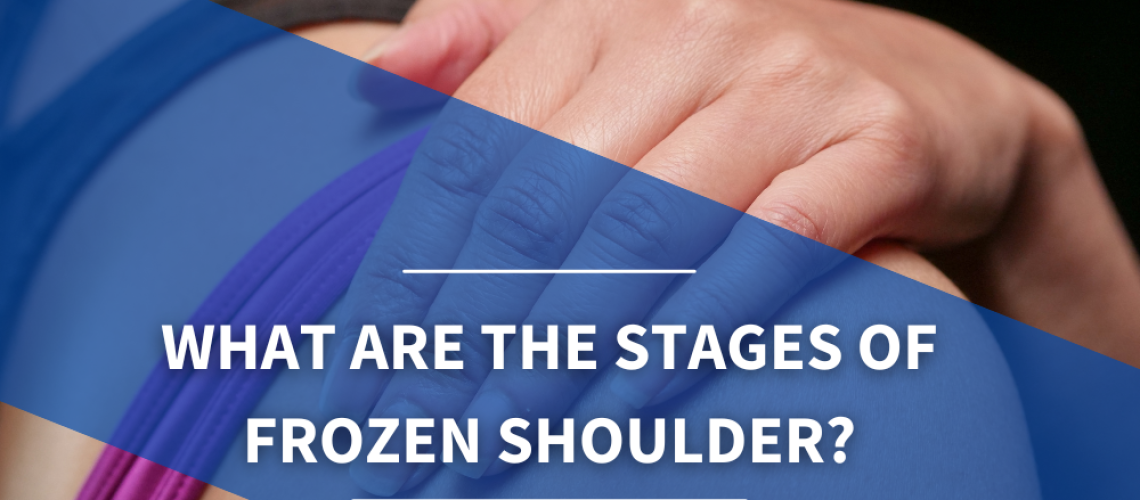What are the stages of frozen shoulder?
Frozen shoulder is a condition that causes pain and limits your mobility.

If you’re affected, you’ll be keen to know more and understand its three phases.
Read on to know the answers to your questions and to find out what treatment can bring you relief wherever you are on your journey.
What is frozen shoulder?
Frozen shoulder (1) is another name for adhesive capsulitis. It occurs when the tissues in your shoulder joint thicken and become tighter, and as a result, scar tissue develops.
This means that your shoulder joint doesn’t have enough space to rotate as it should, and you may experience stiffness, swelling and pain. This will limit your mobility and the range of tasks you can carry out.
Frozen shoulder is more common in people aged 40 to 60 and affects more women than men. People who have diabetes or have been inactive for a long time are at higher risk of developing it.
Stage one: the freezing stage
This stage lasts between two and nine months. The patient will notice changes to their shoulder mobility and pain and stiffness, which tend to get worse over time.
Stage two: the frozen stage
During this stage, which tends to last between four months to one year, the shoulder is truly “frozen” as mobility is severely reduced. For example, the patient may not be able to raise their arm above their head or even part of the way.
Stage three: the thawing stage
This final stage generally takes six months to two years. However, many people find that their frozen shoulder gets better by itself during this time.
Signs that frozen shoulder is starting to thaw include an improvement in the patient’s range of movement and a feeling that the shoulder is loosening up.
Frozen shoulder treatment
While it’s possible for frozen shoulder to improve without treatment, it can be a long and frustrating experience. That’s why many people seek help in the early stages of frozen shoulder.

Treatment options include:
- Physiotherapy to gently stretch the shoulder joint
- Medication to reduce inflammation
- A steroid injection in the shoulder joint
- Ice packs on the shoulder for 15 minutes a day
- Surgery to remove or release scar tissue
Osteopathy for frozen shoulder
Osteopathy is also an effective, non-invasive treatment for frozen shoulder. Typically, your frozen shoulder osteopathy will offer you a combination of shockwave therapy, which uses acoustic waves to trigger healing, and exercises to relieve pain and stiffness.
These are both tried-and-tested methods to help with frozen shoulder. A study (2) that looked at the effects of shockwave therapy on people with frozen shoulder found it to be an effective treatment, while another (3) found that exercise promoted significant improvements.
Frozen shoulder osteopathy near you
Looking for a frozen shoulder osteopath near you in Calgary? Then reach out to us at Osteo Health.
We are experts in helping to restore you to your best possible self — and that includes relieving the pain and stiffness of frozen shoulder.
Call us at 403-814-0404 or book your appointment online at osteohealthcalgary.janeapp.com.
Approved by Indira Ravaeva. Manual Osteopath. Member of National Manual Osteopathic Society and Osteopathy Australia.
References
1. Healthline website, ‘Frozen Shoulder,’ Mar 31, 2017. https://www.healthline.com/health/frozen-shoulder
2. Park C, Lee S, Yi C, Lee K. ‘The effects of extracorporeal shock wave therapy on frozen shoulder patients’ pain and functions,’ Journal of Physical Therapy Science, 2015 Dec; 27(12): 3659–3661. Published online 2015 Dec 28. DOI: 10.1589/jpts.27.3659
3. Cho C, Bae K, Kim D. ‘Treatment Strategy for Frozen Shoulder’, Clinics in Orthopaedic Surgery, 2019 Sep; 11(3): 249–257. Published online 2019 Aug 12. DOI: 10.4055/cios.2019.11.3.249.
Also used in research but not referenced in the article:
World Frozen Shoulder Clinic website, ‘Understanding The Stages of Frozen Shoulder,’ Feb 16, 2021. https://frozenshoulderclinic.com/stages/

